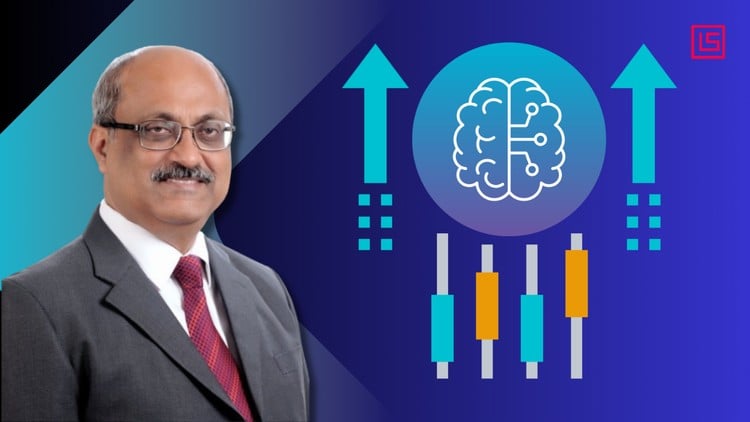
Learn to Build and Backtest LSTM-Based Trading Strategies Using Technical Indicators and Real Market Data
⏱️ Length: 1.5 total hours
⭐ 4.48/5 rating
👥 5,375 students
🔄 August 2025 update
Add-On Information:
Note➛ Make sure your 𝐔𝐝𝐞𝐦𝐲 cart has only this course you're going to enroll it now, Remove all other courses from the 𝐔𝐝𝐞𝐦𝐲 cart before Enrolling!
-
Course Overview
- Dive into the cutting-edge of algorithmic trading by harnessing the power of Deep Learning, specifically focusing on Long Short-Term Memory (LSTM) networks.
- This course goes beyond traditional signal-based trading, empowering you to construct intelligent, adaptive trading systems that learn from historical market dynamics.
- Explore the architecture and capabilities of LSTMs, understanding why they are particularly suited for sequential data like financial time series.
- Gain a profound understanding of how to integrate sophisticated technical indicators into your deep learning models, creating richer and more informative predictive features.
- Learn to translate raw market data into actionable trading decisions, moving from raw data to sophisticated signal generation.
- Discover the practical aspects of developing and refining your own LSTM trading strategies from conception to deployment.
- Understand the crucial role of data preprocessing and feature engineering in building robust deep learning trading models.
- Explore advanced techniques for dealing with the inherent challenges of financial data, such as noise and non-stationarity.
- Acquire the skills to rigorously test and validate your trading strategies, ensuring they perform reliably in simulated market conditions.
- This course is designed to equip you with a comprehensive toolkit for building the next generation of AI-powered trading algorithms.
-
Requirements / Prerequisites
- A foundational understanding of Python programming is essential, as the course heavily utilizes Python for implementation.
- Familiarity with basic machine learning concepts will be beneficial, though core deep learning principles will be introduced.
- Access to a computer with Python installed and the necessary libraries (e.g., TensorFlow, Keras, Pandas, NumPy, Matplotlib) is required.
- A willingness to learn and experiment with financial market data is key.
- Basic knowledge of algorithmic trading concepts will enhance the learning experience, but is not strictly mandatory.
- Comfort with working with data analysis and visualization tools.
-
Skills Covered / Tools Used
- Deep Learning Fundamentals: Grasping the core principles of neural networks, particularly recurrent neural networks and LSTMs.
- Financial Data Manipulation: Proficiency in using libraries like Pandas and NumPy for cleaning, transforming, and analyzing stock market data.
- Feature Engineering for Time Series: Developing creative ways to derive meaningful features from historical prices and technical indicators.
- LSTM Model Development: Hands-on experience in building, configuring, and training LSTM models for predictive tasks.
- Model Evaluation Metrics: Understanding and applying appropriate metrics to assess the performance of predictive models in a financial context.
- Risk Management Metrics: Calculating and interpreting key financial risk indicators to evaluate strategy viability.
- Backtesting Frameworks: Implementing robust backtesting procedures to simulate trading strategy performance.
- Data Visualization: Creating clear and informative visualizations to interpret model predictions and strategy outcomes.
- Python Libraries: Extensive use of TensorFlow, Keras, Pandas, NumPy, Scikit-learn, and Matplotlib.
- Technical Indicator Integration: Practical application of incorporating indicators like Moving Averages, RSI, MACD, etc., into AI models.
-
Benefits / Outcomes
- Develop the confidence to build and deploy your own AI-driven trading strategies.
- Gain a significant edge in the market by moving beyond simplistic trading signals to truly predictive models.
- Enhance your understanding of financial markets through the lens of advanced data science and machine learning.
- Acquire in-demand skills in deep learning and algorithmic trading, opening doors to new career opportunities.
- Learn to objectively assess the profitability and risk of your trading ideas before committing real capital.
- Become adept at identifying and capitalizing on complex patterns in market data that traditional methods might miss.
- Empower yourself to create more robust and adaptable trading systems that can evolve with market conditions.
- Understand the practical challenges and solutions involved in applying deep learning to real-world trading scenarios.
- Build a strong foundation for further exploration into more advanced AI techniques for finance.
- Attain the ability to critically evaluate existing trading strategies and identify areas for improvement.
-
PROS
- Focuses on a highly relevant and powerful deep learning architecture (LSTM) for time series data.
- Practical, hands-on approach to building and backtesting strategies, moving beyond theoretical concepts.
- Covers essential topics for evaluating trading performance and risk, crucial for real-world application.
- Addresses the common challenge of imbalanced financial data with practical solutions.
- Provides a solid pathway to understanding AI’s transformative impact on trading.
-
CONS
- The 1.5-hour duration might limit the depth of exploration on highly complex sub-topics, requiring further self-study for mastery.
Learning Tracks: English,Finance & Accounting,Investing & Trading
Found It Free? Share It Fast!